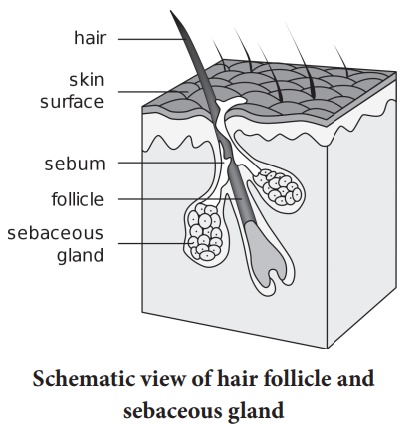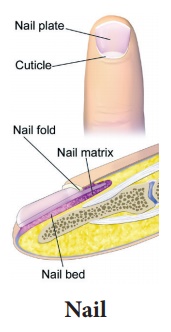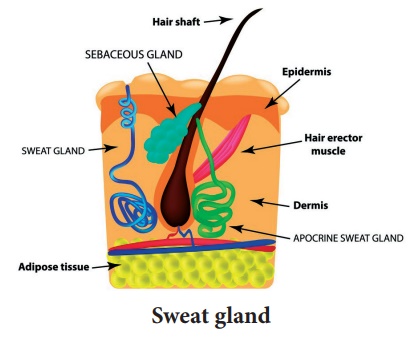Chapter: 12th Nursing : Chapter 1 : Human Anatomy and Physiology
Integumentary System
Integumentary System
It comprises the skin and its appendages which protects the body
from various kinds of damages such as loss of water or damages from outside.
The integumentary system consists of the
·
Skin
·
Hair
·
Finger and toe nails
·
Sebaceous glands
·
Sweat glands
Skin
The human skin is the outer covering of the body and is the
largest organ of the integumentary system. The main functions are protection,
regulation and sensation.

The skin has the following layers from exterior to the inner layer.
·
The epidermis
·
The dermis
·
The hypodermis (subcutaneous layer)
The epidermis is a vascular (without blood vessels); the skin
contains keratin which protects and prevents the skin from becoming water
logged.
The dermis, the middle layer of the skin, contains blood vessels,
gives the skin its elasticity to stretch.
The hypodermis, the subcutaneous layer, stores fat that are ready
for use when energy is needed. This layer of skin fat also maintains body
temperature by serving as an insulator.
Hair
Hair keeps the body warm. Hair covers the majority of the body
surface; thick hair is found on the head and face and fine hair is found on
other parts of the body such as the pubic area. Hair has a follicle below the
skin, and a shaft above the skin. Hair contains keratin.

Sebaceous Glands
Sebaceous glands are exocrine glands. It lubricate and moisturize
the skin with an oily secretion which is called as sebum and maintains
thermoregulation.
Nail
The finger and toe nails are made of keratin. Nails protect the
tips of our fingers and toes from injury.
Three parts of the nail are:
·
Nail bed
·
Nail matrix
·
Nail plate

Sweat Glands
Sweat glands are exocrine and apocrine glands that secretes sweat
to the surface of the skin. They are found under the arms in the axillary area
and perform little function in humans. Sweat glands, are exocrine glands
secrete a substance that cools the body off with perspiration and eliminate
wastes.

Disease related to Integumentary system
• Acne
• Rash
• Athlete’s foot
• Pressure ulcers
• Sunburn
• Skin cancer
• Albinism
• Herpes
• Impetigo
• Psoriasis
• Rosacea
Functions of Integumentary System
·
Protects the body against the external environment as the first
line of defence from germs and infections.
·
The skin, its thickness and sweat glands, maintain the body
temperature
·
Vitamin D production
·
Protection against UV rays
·
Perspiration.
·
Dehydration
·
Reception of tactile sensory messages such as heat, cold, and pain
sensations.
Related Topics